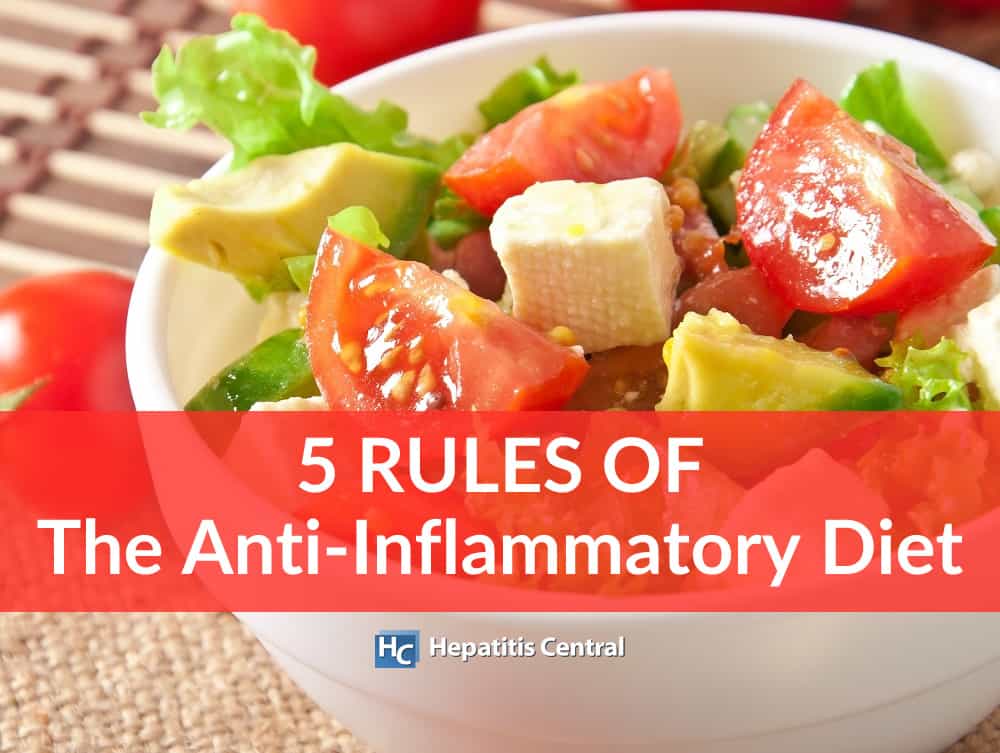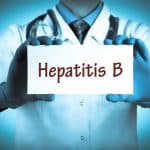5 Rules of The Anti-Inflammatory Diet


Last Reviewed November 11, 2019
If you are one of the estimated three and a half million Americans with the Hepatitis C virus, your liver is the setting of a continual battle against inflammation. Because the liver eventually processes everything we eat or drink, every food and beverage choice impacts this battle by either assisting in inflammation reduction or aggravating hepatic inflammation. By sticking to the principles of the anti-inflammatory diet, the damage Hepatitis C can cause to your liver is greatly impaired.
Hepatitis literally translates to liver inflammation. Thus, minimizing liver inflammation reduces the severity of all types of hepatitis – including Hepatitis C. This viral infection usually progresses slowly, frequently taking many years before symptoms manifest.
- Hepatitis C progression occurs when liver cell death outpaces liver cell regeneration.
- Inflammation initiates the sequence of events that kills liver cells.
- Inhibiting liver inflammation slows Hepatitis C’s destructive capabilities.
Guidelines
Most healthcare providers recognize the anti-inflammatory diet as a valuable strategy for prohibiting Hepatitis C infection from escalating. The anti-inflammatory diet is not a diet in the popular sense, where precise caloric parameters or specific food combinations are followed. Instead, the anti-inflammatory diet offers guidelines for eating based on the biochemical properties of food.
5 Principles for The Anti-Inflammatory Diet
- Good Fat – The importance of choosing good fat (monounsaturated, polyunsaturated, medium chain fatty acids and omega 3-fatty acids) is a crucial element to the anti-inflammatory diet. Good fats can lower bad cholesterol, preventing inflammation in blood vessels and organs – including the liver.
- Fiber – Also referred to as roughage, fiber reduces inflammation by supplying anti-inflammatory nutrients and by binding with inflammatory substances that aid in their elimination from the body. Nutritionists suggest aiming for 25-40 grams of fiber each day.
- Fruit and Veggies – Fresh produce contains an abundance of vitamins, minerals and antioxidants. The anti-inflammatory diet hinges on antioxidants because these chemicals neutralize free radicals – molecules that create inflammation and damage cells.
- Antioxidants – Abundant in fruit, vegetables, spices and supplements, antioxidants are the soldiers on the frontline of the inflammation battle. Antioxidants neutralize free radicals by donating an electron, preventing free radicals from stealing an electron from a neighboring cell. This electron theft initiates inflammation and perpetuates liver cell death.
- Skip Inflammatory Foods – An invaluable component of the anti-inflammatory diet is avoiding foods that fan the flames of inflammation. Foods to skip (or at least minimize) include processed foods, foods with refined sugar or high-fructose corn syrup, foods high in sodium, artificial sweeteners and trans fats.
Healthy Eats for The Anti-Inflammatory Diet
Nutritionists insist that the best diets recruit a wide variety of foods. Thus, there is no specific menu for the anti-inflammatory diet. However, the following suggestions for each of the five dietary principles are endorsed by healthcare providers and supported by a large cannon of research.
- Good Fat – Oily, cold water fish like salmon, trout, mackerel, tuna and sardines; avocados, extra-virgin olive oil, coconut oil, flax seeds, hemp seeds, nuts, and expeller-pressed, organic canola oil.
- Fiber – Brown rice, quinoa, barley, oatmeal, okra, eggplant, apples, avocado, banana, berries, figs, artichokes, peas, acorn squash, black beans, lima beans, lentils, almonds and chia seeds.
- Fruit and Veggies – Spinach, dandelion greens, kale, carrots, celery, squash, berries, oranges, lemons, melons, peppers, asparagus, green beans, tomatoes, bok choy, onions, bananas, apples, pears, arugula, yams, beets, pineapple, collards and cherries.
- Antioxidants – Brightly colored produce, green leafy vegetables, green tea, turmeric, ginger, tart cherries, garlic, dark chocolate, tomatoes, citrus fruit, broccoli, nuts, chili peppers, beets and grapes.
- Skip These Foods – Fast food, deep-fried food, pastries, vegetable shortenings, margarines, crackers, cakes, cookies, palm oil, poultry skin, fatty dairy foods, fatty pork or beef, non-dairy creamer, artificial sweeteners, soda, sugar, white bread, alcohol, MSG and chips.
The foods listed above are not exclusive, but rather a good start to figuring out which foods to choose and which to avoid while working with the anti-inflammation diet.
Because the Hepatitis C virus is continually inciting inflammation in the liver, adopting all five principles of the anti-inflammation diet represents one of the best strategies for protecting against advancing illness.
Editor’s Note: Turmeric 95 is one of the most potent and effective forms of turmeric. It destroys proteins and enzymes that cause inflammation. It also improves bile production and flow which aids in digestion, immunity and overall liver health.
The 5 best foods to eat if you want to reduce inflammation. (n.d.). Retrieved November 11, 2019, from https://www.liverdoctor.com/5-best-foods-eat-want-reduce-inflammation/
Cutler, N., LAc, MTCM, Dipl. Ac (NCCAOM). (2015, April 3). 9 foods to restrain the Hepatitis C virus. Retrieved November 11, 2019, from https://www.hepatitiscentral.com/news/9-foods-to-restrain-the-hepatitis-c-virus/
Dr. Weil's anti-inflammatory diet. (2019, September 27). Retrieved November 11, 2019, from https://www.drweil.com/diet-nutrition/anti-inflammatory-diet-pyramid/dr-weils-anti-inflammatory-diet/
Dr. Weil's anti-inflammatory diet. (n.d.). Retrieved November 11, 2019, from https://health.usnews.com/best-diet/anti-inflammatory-diet
Kaplan, G., DO. (2019, October 04). Anti-Inflammatory Diets: 11 Rules For Optimal Health. Retrieved November 11, 2019, from https://www.mindbodygreen.com/0-22607/antiinflammatory-diets-11-rules-for-optimal-health.html
Link, R., MS, RD. (2019, August 07). Top 23 high-fiber foods and the benefits of each. Retrieved November 11, 2019, from https://draxe.com/nutrition/high-fiber-foods/
Louis, P. (2013, July 21). Reduce inflammation effortlessly by taking these top antioxidants. Retrieved November 11, 2019, from http://www.naturalnews.com/041293_chronic_inflammation_immune_system_antioxidants.html
Reinagel, M., MS, LN, CNS. (2018, July 13). 10 Anti-inflammatory recipes to prevent disease and help weight loss. Retrieved November 11, 2019, from https://www.epicurious.com/expert-advice/anti-inflammatory-recipes-to-prevent-disease-and-help-weight-loss-article
Zelman, K., MPH, RD, LD. (n.d.). Good fats vs. bad fats: Get the skinny on fat. Retrieved November 11, 2019, from https://www.webmd.com/diet/obesity/features/skinny-fat-good-fats-bad-fats#1








3 Comments
To bad the tumeric you sell still isn’t absorbable enough to get all those benefits you stated. Research people.
We were not taught grams & fiber etc. We were taught food group and servings. Can someone make or easier for us and our age?
Fiber is oats and other grains. It is also found in fruit and vegetables. 25-40 grams is about half a cup